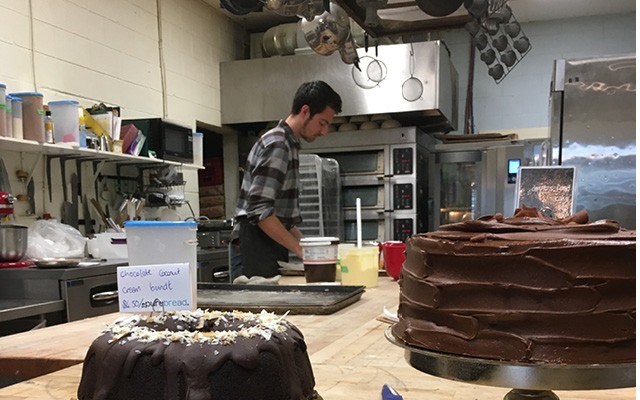The monster is plopped on the table with little ceremony. Loosed from the confines of the plastic bin in which it has incubated, it seems momentarily to consider escape, flattening to spread briefly in every direction at once. But this is only a nod to gravity, and it goes no farther. It's clear there's cohesion to this creature, some internal inchoate structure keeping it together. But when it's descended upon by a youthful cabal of Canadians, Australians, Germans and Japanese, quivering like Jabba the Hutt at every touch, it is nevertheless mercilessly pulled apart.
The "monster" is an enormous dough; the place, Purebread's bread-baking and retail facility in Function Junction; the scene, one that plays out many times each day, and the descending hands those of the shaping crew, each of whom has a role. With a large paddle blade, one cuts and weighs pieces of dough, another crudely shapes these and the next finishes by putting them onto trays stacked on rolling racks. The scene becomes less sci-fi surreal and more logical assembly as the amorphous lump metamorphoses before my eyes into a series of precise and symmetrical oven-ready loaves. In short order, the monster is gone and another arrives, this one an entirely different beast.
Now the boys cut and lay out focaccia, four by each, more tractable with less shaping involved, but with an added wrinkle: before baking they must be garnished; Jens, the bread manager, dimples each loaf with practised fingers before brushing it generously with olive oil and adding basil leaves, cherry tomatoes and salt. "It looks good — and it tastes good," he smiles when he catches me looking.
Jens is from a small village in Germany where, he says, it didn't take much to get into baking. "One good thing about being a baker is that you can get a job anywhere," he quips while shoving trays into one of three massive ovens. "And free bread!" pipes up someone else.
While I daydream about how these beauties will taste when they're done, the table is cleared and another dough decanted from one of a dozen bins stacked in a prep area so cramped you are always in someone's way, no matter what you're doing. Now I note the job's physicality, a genuine workout as shapers roll, fold, knead and pull. It might be even more of a workout — physically and mentally — for supervisor Matthew Knight, a.k.a. "Doug" who loads, minds and empties the bins while simultaneously having several mechanical dough mixers on the go and an eye to a complex schedule of breads that need to be available daily (e.g., disfunction ale, rustic Italian), on particular days (lavender rosemary for Friday, Saturday and Sunday), or but once a week (Sunday's high bread).
There are three main things on this schedule — mix, shape, and bake. Doug arrives a couple hours before the others to start the Dinkel (made with spelt and ergo, gluten-freeish) and cheddar jalapeño dough and lay the groundwork for the rest of this complex dance. The shaping starts about an hour before baking begins at 4 p.m. In between is art, chemistry, calculation and strategizing the likes of which I never imagined.
Different bread doughs have rise times ranging from two to 18 hours, and need to be turned on certain schedules, accounting for the timers atop most of the bins and the fact that Doug is constantly ripping off lids, bending and reaching in with both hands to flop over what is in essence a giant living organism the size of a child. In addition he times mixers, figures out how many loaves of each type are needed, and makes the required adjustments. It's a logistical tour de force — the ultimate in multitasking.
"It's easy to mess things up, not measure yeast or something else properly and then not find out until the next day," says Doug, turning doughs that have sat for 20 (seriously seedy), 40 (whole wheat) and 60 minutes (white). I watch closely as he turns the ciabatta, fastidiously bursting the largest bubbles but not the small. Tearing the dough wrecks the gluten fibres assembling within it (that inchoate structure).
"You can go from helping it out to wiping it out if you're not careful," he notes.
Despite the high output here nothing is factory-esque, with much hands-on work. "You know by feel when the texture isn't right, and it may be the difference between a half a handful of flour," says Doug, throwing just that into a loudly grinding mixer. Because temperature and water amounts are adjusted based on season and flour quality, Doug measures room, flour, and water temperatures to get the right output from yeast cultures, which die when temperatures get too high.
The last loaf is usually baked by 11 p.m., but when there are markets on, it might go until 2 a.m. Bread that doesn't get sold is frozen, and when enough of it accumulates, it's taken to the food bank... so that even the less fortunate in the valley can have a taste of pure bread magic.
Leslie Anthony is a Whistler-based author, editor, biologist and bon vivant who has never met a mountain he didn't like.




